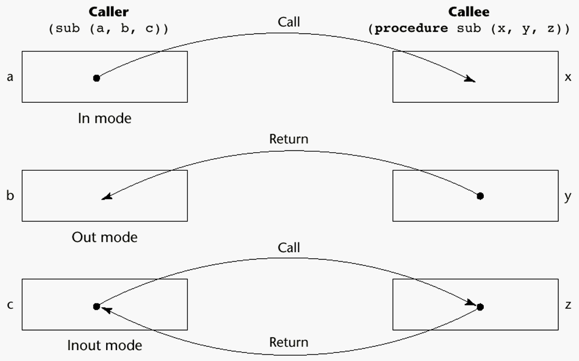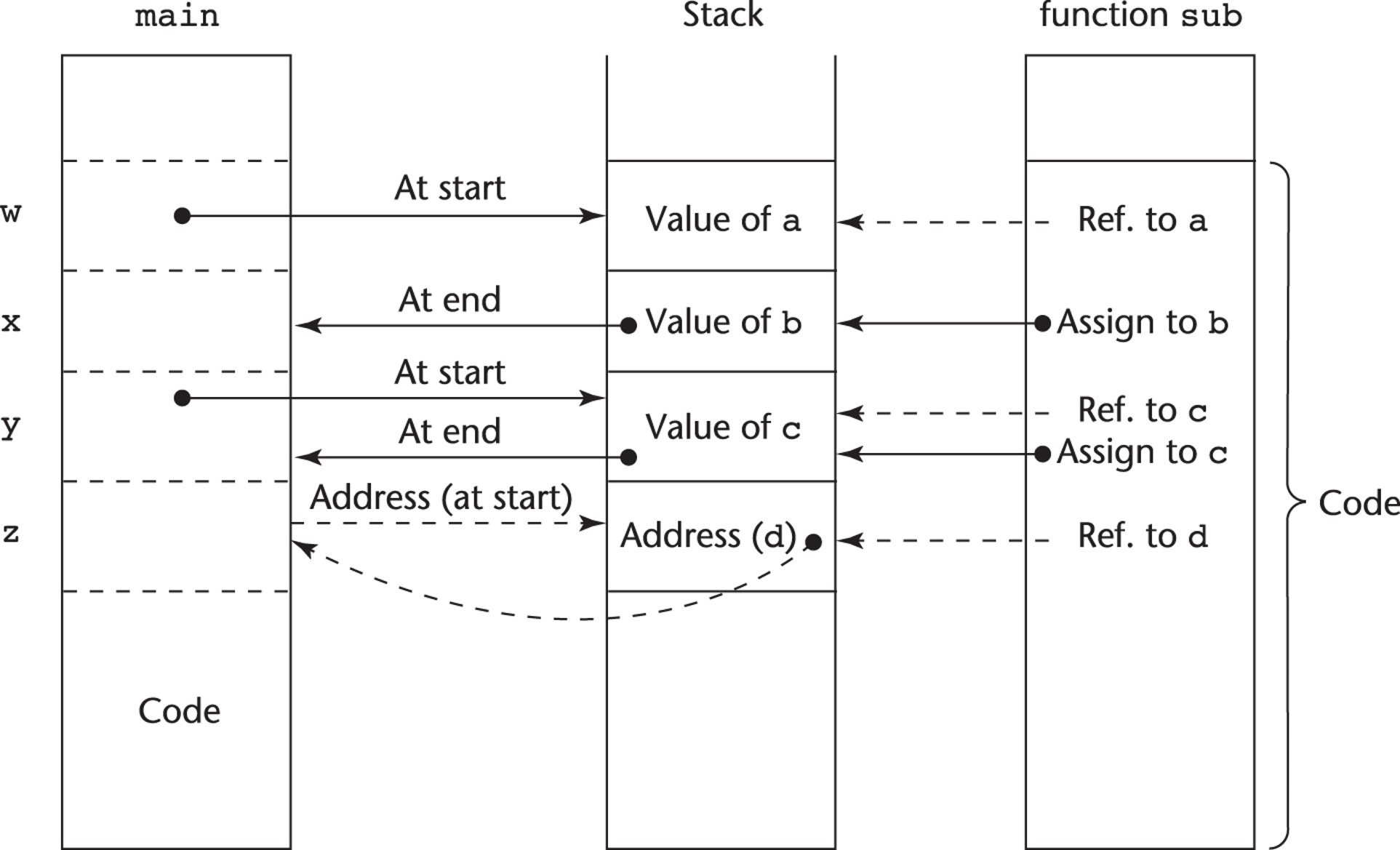12 - Subprograms#
Fundamentals of Subprograms#
Each subprogram has a single entry point
The calling program is suspended during execution of the called subprogram
Control always returns to the caller when the called subprogram’s execution terminates
Basic Definitions#
A subprogram definition describes the interface to and the actions of the subprogram abstraction.
In Python, function definitions are executable; in all other languages, they are non-executable.
In Ruby, function definitions can appear either in or outside of class definitions. If outside, they are methods of
Object. They can be called without an object, like a function.
A subprogram call is an explicit request that the subprogram be executed.
A subprogram header is the first part of the definition, including the name, the kind of subprogram, and the formal parameters.
The parameter profile (a.k.a. signature) of a subprogram is the number, order, and types of its parameters.
The protocol is a subprogram’s parameter profile and, if it’s a function, its return type.
A subprogram declaration provides the protocol, but not the body, of the subprogram.
Function definitions in C and C++ are often called prototypes.
A formal parameter is a dummy variable listed in the subprogram header and used in the subprogram.
An actual parameter represents a value or address used in the subprogram call statement.
Actual/Formal Parameter Correspondence#
Actual parameters can be bound to formal parameters in one of two ways:
Positional: The first actual parameter is bound to the first formal parameter. This is safe and effective.
Keyword: The name of the formal parameter to which an actual parameter is to be bound is specified with the actual parameter.
Advantage: Parameters can appear in any order, thereby avoiding parameter correspondence errors
Disadvantage: User must know the formal parameter’s names
Formal Parameter Default Values#
In certain languages (e.g. C++, Python, Ruby, PHP), formal parameters can have default values (if no actual parameter is passed).
In C++, default parameters must appear last because parameters are positionally associated (no keyword parameters).
Variable Numbers of Parameters#
C# methods can accept a variable number of parameters as long as they are of the same type. The corresponding formal parameter is an array preceded by params.
In Ruby, the actual parameters are sent as elements of a hash literal and the corresponding formal parameter is preceded by an asterisk.
In Python, the actual is a list of values and the corresponding formal parameter is a name with an asterisk.
Procedures and Functions#
There are 2 categories of subprograms:
Procedures are collections of statements that define parameterized computations.
Functions structurally resemble procedures but are semantically modeled on mathematical functions.
They are expected to produce no side effects
In practice, program functions have side effects
Design Issues for Subprograms#
Are local variables static or dynamic?
Can subprogram definitions appear in other suprogram definitions?
What parameter passing methods are provided?
Are parameter types checked?
If subprograms can be passed as parameters and subprograms can be nested, what is the referencing environment of a passed subprogram?
Are functional side effects allowed?
What types of values can be returned from functions?
How many values can be returned from functions?
Can subprograms be overloaded?
Can subprograms be generic?
If the language allows nested subprograms, are closures supported?
Local Referencing Environments#
Local variables can be stack-dynamic.
Advantages: Support for recursion; Storage for locals is shared among some subprograms
Disadvantages: Allocation/deallocation, initialization time; Indirect addressing; Subprograms cannot be history sensitive
Local variables can be static.
Advantages and disadvantages: Opposite of those of the stack-dynamic
In most contemporary languages, locals are stack dynamic. In C-based languages, locals are stack dynamic by default, but can be declared static. The methods of C++, Python, Java, and C# only have stack dynamic locals.
Parameter-Passing Methods#
The following methods exist for passing parameters:
In mode
Out mode
Inout mode
Models of parameter passing:

Conceptual models of transfer:
Physically move a value
Move an access path to a value
Pass-by-Value (In Mode)#
In pass-by-value, the value of the actual parameter is used to initialize the corresponding formal parameter.
Normally implemented by copying
Can be implemented by transmitting an access path but not recommended (enforcing write protection is not easy)
Disadvantages (if by physical move): additional storage is required (stored twice) and the actual move can be costly (for large parameters)
Disadvantages (if by access path method): must write-protect in the called subprogram and accesses cost more (indirect addressing)
Pass-by-Result (Out Mode)#
When a parameter is passed by result, no value is transmitted to the subprogram. The corresponding formal parameter acts as a local variable. Its value is transmitted to caller’s actual parameter when control is returned to the caller by physical move. This requires extra storage location and copy operations.
This can potentially cause problems:
sub(p1, p1): whichever formal parameter is last copied back will represent the current value ofp1sub(list[sub], sub): Compute address oflist[sub]at the beginning of the subprogram or end?
Pass-by-Value-Result (Inout Mode)#
Pass-by-value-result is a combination of pass-by-value and pass-by-result. It is sometimes also called pass-by-copy. In this mode, formal parameters have local storage.
Disadvantages: same as those of pass-by-value and pass-by-result
Pass-by-Reference (Inout Mode)#
Pass-by-reference (a.k.a. pass-by-sharing) passes the path to the parameter.
Advantage: Passing process is efficient (no copying and no duplicated storage)
Disadvantages
Slower accesses (compared to pass-by-value) to formal parameters
Potentials for unwanted side effects
Unwanted aliases (access broadened)
foo(total, total); foo(list[i], list[j]); foo(list[i], list)
Pass-by-Name (Inout Mode)#
Pass-by-name uses textual substitution. Formals are bound to an access method at the time of the call, but actual binding to a value or address takes place at the time of a reference or assignment.
Pass-by-name allows flexibility in late binding.
Implementation requires that the referencing environment of the caller is passed with the parameter, so the actual parameter address can be calculated.
Implementing Parameter-Passing Methods#
In most languages, parameter communication takes place through the run-time stack. Pass-by-reference is the easiest to implement, as only the address is placed in the stack.

Function header:
void sub(int a, int b, int c, int d)Function call in main:
sub(w, x, y, z)(passwby value,xby result,yby value-result,zby reference)
Parameter Passing Methods of Major Languages#
C
Pass-by-value
Pass-by-reference is achieved by using pointers as parameters
C++
A special pointer type called reference type for pass-by-reference
Java
All non-object parameters are passed by value, so no method can change any of these parameters
Object parameters are passed by reference
Fortran 95+
Parameters can be declared to be in, out, or inout mode
C#
Default method: pass-by-value
Pass-by-reference is specified by preceding both a formal parameter and its actual parameter with
ref
PHP
Very similar to C#, except it uses
&
Swift
Default passing method is by value, but pass-by-reference can be specified by preceding the formal with
inout
Perl
All actual parameters are implicitly placed in a predefined array named
@_
Python and Ruby
Use pass-by-assignment (all data values are objects); the actual is assigned to the formal (pass-by-reference)
Type Checking Parameters#
Considered very important for reliability
FORTRAN 77 and original C had no type checking
Most later languages require type checking
Relatively new languages Perl, JavaScript, and PHP do not require type checking
In C89, the choice is made by the user
In Python and Ruby, variables do not have types (objects do), so parameter type checking is not possible
Multidimensional Arrays as Parameters#
If a multidimensional array is passed to a subprogram and the subprogram is separately compiled, the compiler needs to know the declared size of that array to build the storage mapping function.
In C and C++,
The programmer is required to include the declared sizes of all but the first subscript in the actual parameter
This disallows writing flexible subprograms
Solution: Pass a pointer to the array and the sizes of the dimensions as other parameters; the user must include the storage mapping function in terms of the size parameters
In Java and C#,
Arrays are objects, they are single-dimensioned, but the elements can be arrays
Each array inherits a named constant (
lengthin Java,Lengthin C#) that is set to the length of the array when the array object is created
Design Considerations for Parameter Passing#
There are 2 important considerations:
Efficiency
One-way or two-way data transfer
However, these considerations are in conflict
Good programming suggests limited access to variables outside, which means one-way whenever possible
But pass-by-reference is more efficient to pass structures of significant size
